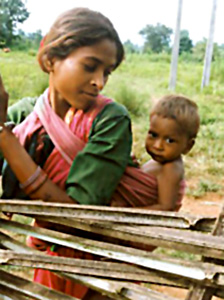 Tribes in Dantewada District have their own native cultures and traditions. Even though this district of Chhattisgarh is surrounded by three states namely Maharashtra, Andhra Pradesh and Orissa, it has still maintained its indigenous identity. In spite of the influence of its neighbours in every sphere like living, eating, drinking, dressing, speaking, ornamentation, folk art, folk literature; the cultural identity of the tribes of Dantewada is safe and secure. Dantewada District is inhabited by several tribal groups, out of which three main tribes are found widely in the district namely Gond Tribe, Dorla Tribe and Halba Tribe.
Tribes in Dantewada District have their own native cultures and traditions. Even though this district of Chhattisgarh is surrounded by three states namely Maharashtra, Andhra Pradesh and Orissa, it has still maintained its indigenous identity. In spite of the influence of its neighbours in every sphere like living, eating, drinking, dressing, speaking, ornamentation, folk art, folk literature; the cultural identity of the tribes of Dantewada is safe and secure. Dantewada District is inhabited by several tribal groups, out of which three main tribes are found widely in the district namely Gond Tribe, Dorla Tribe and Halba Tribe.
The tribes of Dantewada District are mainly non-vegetarians and they habitually take liquors. The Tribal ladies of this region decorate themselves with Khosa (beautiful lock of braid), Khinwa in ears (Ear tops), Phuli on Nose (a hanging ring type ornament made with gold or silver). The tribal ladies embellish their neck with Garland of Karipot (Black Pearl), Chapsari (a heavy necklace), Muhar Mala (A garland made with coins).They also wear Chude, Chudiya (bangles) made from gold, silver, brass, aluminium, clay, lead and wood. They also wear tattoos of different designs. Like all the tribes of India the tribes of Dantewada District too believe in Gods and Goddesses, Jhad Phook (Practice of Occult arts, Exorcism) and black magic. The main occupations of the tribes of the district Dantewada include farming, poultry farming and animal husbandry. They also sell minor forest produces like leaves, fruits, Datun (Fibrous Twin, used as a tooth brush), fire wood, Basta, Boda, Tikhur, Chati, Dhup, Chiraunji (a dry fruit), fish, baskets, soop (handy gadget used for winnowing grains and like) made from Bamboo and many other things.
Tribes of Dantewada District celebrate different fairs and festivals round the year which include the major festivals like Diwali, Holi, Dussehra, Goncha (The Rath Utsav), Fagun etc. and their own festivals are called as Pandum. Pandums are observed by the tribes at different occasions. Interestingly, different types of marriages are prevailing in the tribal society of Dantewada, they are Mangni Vivah (Arranged Marriage), Bahu-Vivah (Polygamy), Vridh Vivah (Old Marriage), Dharjiya Vivah (Inviting the male to become son-in-law, living and depending on the in-laws after marriage), Apharan-Vivah or Jikunanun (Kidnapping and marrying a girl without her consent). The elders of the bridegroom go to the girl`s place for seeking her hand for their boy, which is known as Mahla-Jane, and also bears the whole expenditure of marriage ceremony. There is a custom to celebrate Chatti (the 6th day`s celebration) on the occasion of the child`s birth. Dead bodies are mostly burnt but small children are buried, and there is also a custom of observing Sutak (temporarily separating one self from the normal social gatherings) after the death of the relatives.
Their sources of entertainment are folk songs, dances and folk dramas. These entertainment sources actually reflect the diverse and colourful culture of the people. The folk songs include Leja, Reelo, Mariro, Sona, Dhankul Geet, Chait Parab Geet, Kotni and Jhaliyana Geet, each of which differ from one another and are sung at different occasions. Similarly the types of dances they perform are Dandami-Maria, Gurgal, Karsad, Dandari, Gedi, etc. differs from one another. The main folk dramas of the tribal people of Dantewada District are Giti, Bhatra, Dandari, etc. Apart from these three types of amusements yet another popular way of entertainment is the Murga Ladai (cock fight). Cock fight is so famous in this area that scores of viewers can be found standing around the playground thoroughly enjoying the fight on any fair or weekly market day.
Further, the tribals of Dantewada District are excellent artisans; they are experts in crafting artistic items with clay, stone, bamboo and metals. They express their deep talent and knowledge through gharhwa art, wooden art, and the other crafts they prepare by using shell and peacock feathers. Their main dialects are Halbi, Bhatri, Gondi, Parji, Dharvi, Dorli, Aboojhmarhi and Damdami. Their principal deities are Danteshwari, Mawli Mata, Bhima Dev, Bhairam Dev, Ghat Dev, Aanga Dev and Seethla Devi. Apart from these deities, the tribes of Dantewada District also worship Mother Nature.



















